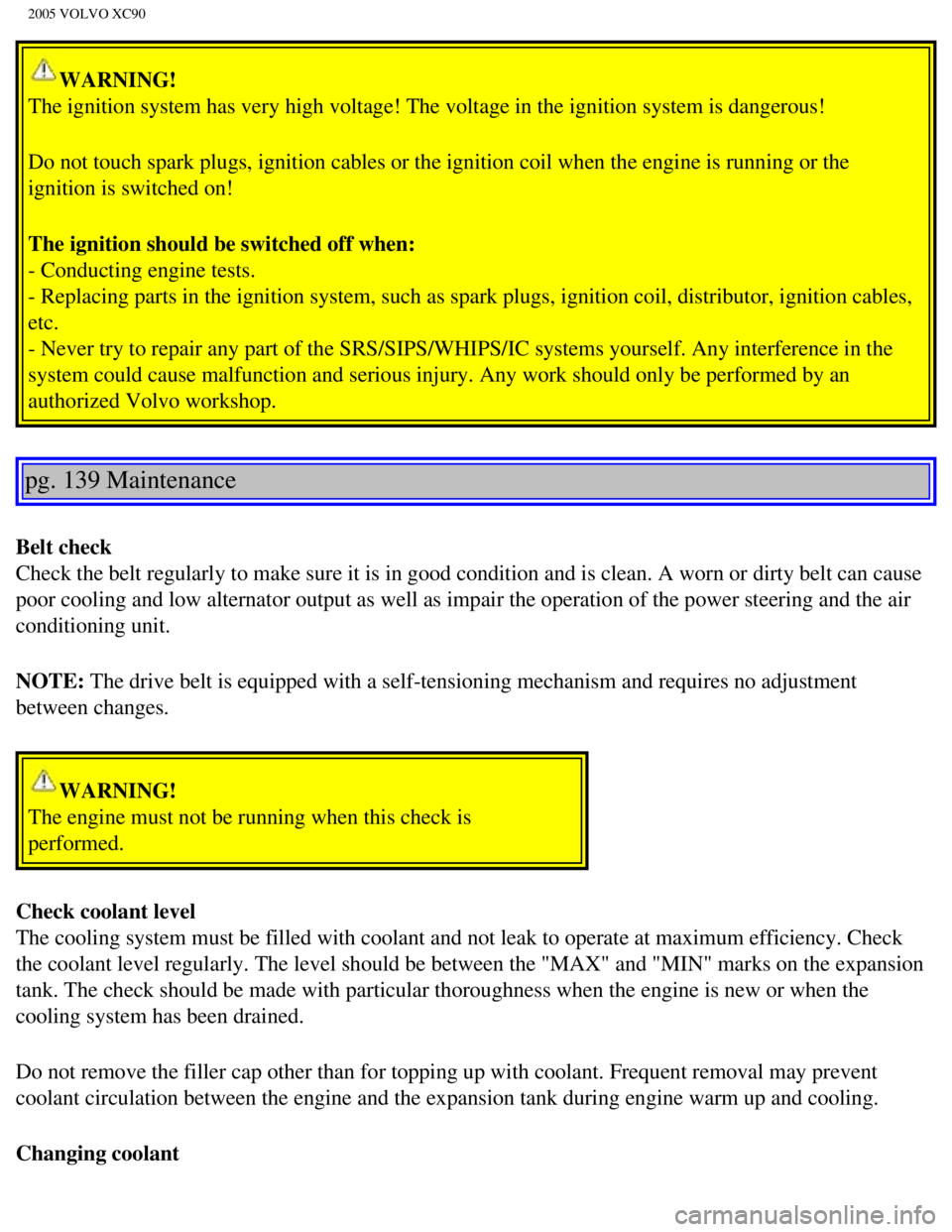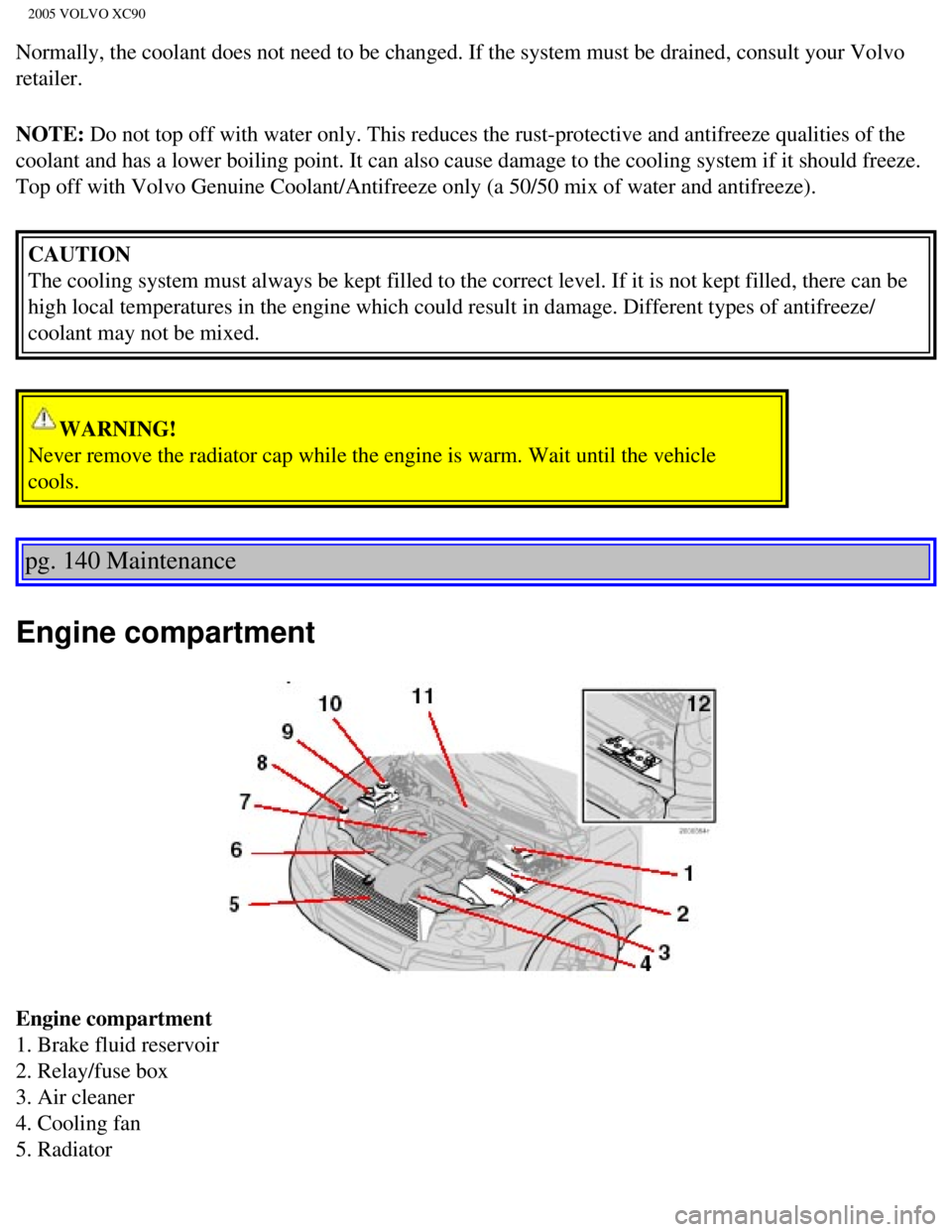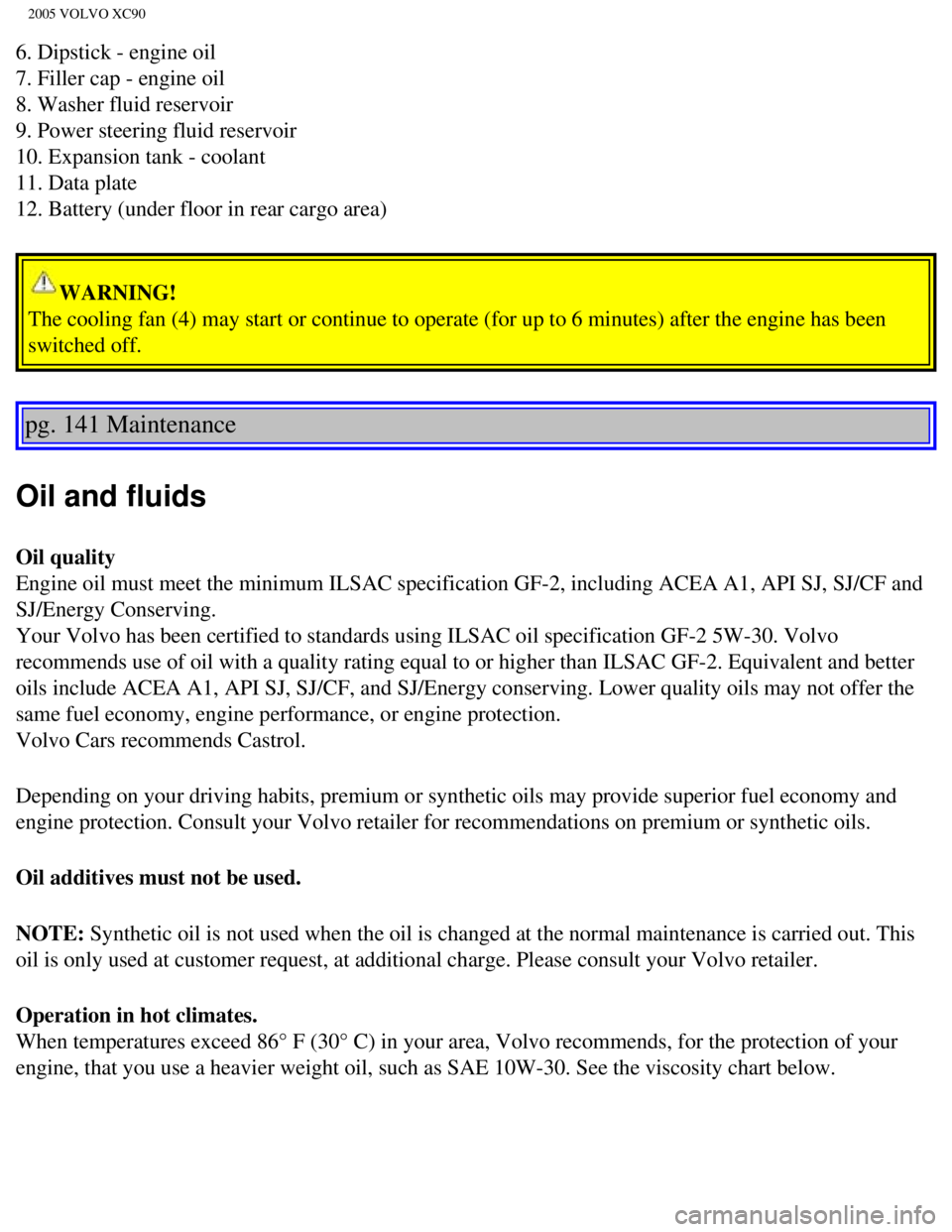VOLVO XC90 2005 Owners Manual
Manufacturer: VOLVO, Model Year: 2005, Model line: XC90, Model: VOLVO XC90 2005Pages: 263, PDF Size: 6.99 MB
Page 171 of 263

2005 VOLVO XC90
7. Crank up the cable again by turning the crank clockwise.CAUTION
When the spare wheel is mounted on the vehicle, the retaining cable coul\
d damage the underside of
the vehicle if it is not retracted.
8. Place the wheel with the flat tire in the vehicle's cargo compartment\
.
NOTE: The space under the vehicle is designed to hold the special spare wheel \
only. Other fullsize
wheels will not fit in this compartment.
6 4:42:37 PM
Page 172 of 263

2005 VOLVO XC90
2 0 0 5
VOLVO XC90
Maintenance
pg. 135 Maintenance
Volvo maintenance136
Working on your vehicle138
Engine compartment140
Oils and fluids141
Battery maintenance146
Bulbs149
Fuses157
pg. 136 Maintenance
Volvo Maintenance
Maintenance
Volvo advises you to follow the maintenance program outlined in the Warr\
anty and Service Records
Information booklet. This maintenance program contains inspections and s\
ervices necessary for the
proper function of your vehicle. The maintenance services contain severa\
l checks which require special
instruments and tools and therefore must be performed by a qualified tec\
hnician. To keep your Volvo in
top condition, specify time-tested and proven Genuine Volvo Parts and Ac\
cessories.
The Federal Clean Air Act - U.S.
The Federal Clean Air Act requires vehicle manufacturers to furnish writ\
ten instructions to the ultimate
purchaser to assure the proper servicing and function of the components \
that control emissions. These
services, which are listed in the "Warranty and Service Records Informat\
ion booklet," are not covered
file:///K|/ownersdocs/2005/2005_XC90/05xc90_09a.htm (1 of 14)12/30/200\
6 4:42:38 PM
Page 173 of 263

2005 VOLVO XC90
by the warranty. You will be required to pay for labor and material used\
.
Maintenance
Your Volvo passed several major inspections before it was delivered to y\
ou, in accordance with Volvo
specifications. The maintenance outlined in the Warranty and Service Rec\
ords Information booklet,
many of which will positively affect your vehicle's emissions, should be\
performed as indicated. It is
recommended that receipts for vehicle emission maintenance be retained i\
n case questions arise
concerning maintenance.
Inspection and maintenance should also be performed anytime a malfunctio\
n is observed or suspected.
Page 137 provides more information about maintenance of emission-related compone\
nts.
Applicable warranties - U.S./Canada
In accordance with applicable U.S. and Canadian regulations, the followi\
ng list of warranties is
provided.
l New Vehicle Limited Warranty
l Parts and Accessories Limited Warranty
l Corrosion Protection Limited Warranty
l Seat Belt and Supplemental Restraint Systems Limited Warranty
l Emission Design and Defect Warranty
l Emission Performance Warranty
These are the federal warranties; other warranties are provided as requi\
red by state/provincial law. Refer
to your separate Warranty and Service Records Information booklet for de\
tailed information concerning
each of the warranties.
Vehicle Event Data
Your vehicle's driving and safety systems employ computers that monitor,\
and share with each other,
information about your vehicle's operation. One or more of these compute\
rs may store what they
monitor, either during normal vehicle operation or in a crash or near-cr\
ash event. Stored information
may be read and used by:
l Volvo Car Corporation
l service and repair facilities
l law enforcement or government agencies
l others who may assert a legal right to know, or who obtain your consent \
to know such information.
pg. 137 Maintenance
Periodic maintenance helps minimize emissions
Periodic maintenance will help keep your vehicle running well. Your Warr\
anty and Service Records
file:///K|/ownersdocs/2005/2005_XC90/05xc90_09a.htm (2 of 14)12/30/200\
6 4:42:38 PM
Page 174 of 263

2005 VOLVO XC90
Information booklet provides a comprehensive periodic maintenance schedu\
le up to 150,000 miles
(240,000 km) of vehicle maintenance. The schedule includes components \
that affect vehicle emissions.
This page describes some of the emission-related components.
Engine air filter
The engine air filter cleans particles from air entering the engine. Rep\
lace the engine air filter cartridge
with a new one every 37,500 miles (60,000 km) under normal driving con\
ditions. Replace the cartridge
more often when the vehicle is driven under dirty and dusty conditions. \
The cartridge cannot be cleaned,
and should always be replaced with a new one.
Fuel filter
The fuel filter should be replaced at 120,000 miles (193,000 km). The \
filter is replaced as a complete
unit. Replace more frequently if contaminated fuel is introduced into th\
e tank, or if there is reason to
suspect that this has occurred.
Fuel system, including filler cap, tank, lines, and connections
The ability of the fuel system to contain hydrocarbons depends upon a le\
ak-free system. Inspect fuel
lines every 30,000 miles (48,000 km). Check for proper sealing of the \
fuel filler cap, which contains "O"
ring seals.
NOTE: If the fuel filler cap is not closed tightly or if the engine is running\
when the vehicle is refueled,
the Check Engine light (Malfunction Indicator) may indicate a fault. H\
owever, your vehicle's
performance will not be affected. Use only Volvo original or approved fu\
el filler caps.
Timing belt
For proper functioning of the engine and emission control systems, the t\
iming belt and belt pretensioner
must be replaced every 120,000 miles (193,000 km) or 10 years, whichev\
er occurs first. Engine damage
will occur if the belt fails.
PCV system
(on turbocharged models)
The nipple in the intake manifold and the filter at the end of the PCV h\
ose in the air cleaner should be
inspected and cleaned at 120,000 miles (193,000 km), and again at 45,0\
00 miles (72,000 km).
Spark plugs
The spark plugs should be replaced every 60,000 miles (96,000 km).
Under normal driving conditions, spark plugs require no maintenance betw\
een replacement intervals.
pg. 138 Maintenance
file:///K|/ownersdocs/2005/2005_XC90/05xc90_09a.htm (3 of 14)12/30/200\
6 4:42:38 PM
Page 175 of 263

2005 VOLVO XC90
Working you your vehicle
Reinforced lifting points
Hoisting the vehicle
If a garage jack is used to lift the vehicle, the two jack attachments p\
oints should be used. They are
specially reinforced to bear the weight of the vehicle (see the illustr\
ation above). A garage jack can also
be placed under the front of the engine support frame. Take care not to \
damage the splash guard under
the engine. Ensure that the jack is positioned so that the vehicle canno\
t slide off it. Always use axle
stands or similar structures. The car's gross vehicle weight is between \
5770 lb (2630 kg) and 6080 lb
(2760 kg). Use a jack and stands rated for this weight.
If a two-post hoist is used to lift the vehicle, the front and rear lift\
arm pads should be centered under the
reinforced lift plates on the inboard edge of the sill rail (see illust\
ration).
Please note the following before you begin working on your vehicle:
Battery (see also
page 148 for more information on handling the battery)
l Ensure that the battery cables are correctly connected and tightened.
l Never disconnect the battery when the engine is running (e.g. when repl\
acing the battery).
l The battery contains acid that is both corrosive and poisonous. It is im\
portant that the battery is
handled in an environmentally friendly way. Let your Volvo retailer assi\
st you.
l Never use a fast charger to charge the battery. The battery cables shoul\
d be disconnected when
recharging.
file:///K|/ownersdocs/2005/2005_XC90/05xc90_09a.htm (4 of 14)12/30/200\
6 4:42:38 PM
Page 176 of 263

2005 VOLVO XC90
WARNING!
The ignition system has very high voltage! The voltage in the ignition s\
ystem is dangerous!
Do not touch spark plugs, ignition cables or the ignition coil when the \
engine is running or the
ignition is switched on!
The ignition should be switched off when:
- Conducting engine tests.
- Replacing parts in the ignition system, such as spark plugs, ignition \
coil, distributor, ignition cables,
etc.
- Never try to repair any part of the SRS/SIPS/WHIPS/IC systems yourself\
. Any interference in the
system could cause malfunction and serious injury. Any work should only \
be performed by an
authorized Volvo workshop.
pg. 139 Maintenance
Belt check
Check the belt regularly to make sure it is in good condition and is cle\
an. A worn or dirty belt can cause
poor cooling and low alternator output as well as impair the operation o\
f the power steering and the air
conditioning unit.
NOTE: The drive belt is equipped with a self-tensioning mechanism and requires\
no adjustment
between changes.
WARNING!
The engine must not be running when this check is
performed.
Check coolant level
The cooling system must be filled with coolant and not leak to operate a\
t maximum efficiency. Check
the coolant level regularly. The level should be between the "MAX" and "\
MIN" marks on the expansion
tank. The check should be made with particular thoroughness when the eng\
ine is new or when the
cooling system has been drained.
Do not remove the filler cap other than for topping up with coolant. Fre\
quent removal may prevent
coolant circulation between the engine and the expansion tank during eng\
ine warm up and cooling.
Changing coolant
file:///K|/ownersdocs/2005/2005_XC90/05xc90_09a.htm (5 of 14)12/30/200\
6 4:42:39 PM
Page 177 of 263

2005 VOLVO XC90
Normally, the coolant does not need to be changed. If the system must be\
drained, consult your Volvo
retailer.
NOTE: Do not top off with water only. This reduces the rust-protective and ant\
ifreeze qualities of the
coolant and has a lower boiling point. It can also cause damage to the c\
ooling system if it should freeze.
Top off with Volvo Genuine Coolant/Antifreeze only (a 50/50 mix of wate\
r and antifreeze). CAUTION
The cooling system must always be kept filled to the correct level. If i\
t is not kept filled, there can be
high local temperatures in the engine which could result in damage. Diff\
erent types of antifreeze/
coolant may not be mixed.
WARNING!
Never remove the radiator cap while the engine is warm. Wait until the v\
ehicle
cools.
pg. 140 Maintenance
Engine compartment
Engine compartment
1. Brake fluid reservoir
2. Relay/fuse box
3. Air cleaner
4. Cooling fan
5. Radiator
file:///K|/ownersdocs/2005/2005_XC90/05xc90_09a.htm (6 of 14)12/30/200\
6 4:42:39 PM
Page 178 of 263

2005 VOLVO XC90
6. Dipstick - engine oil
7. Filler cap - engine oil
8. Washer fluid reservoir
9. Power steering fluid reservoir
10. Expansion tank - coolant
11. Data plate
12. Battery (under floor in rear cargo area)
WARNING!
The cooling fan (4) may start or continue to operate (for up to 6 min\
utes) after the engine has been
switched off.
pg. 141 Maintenance
Oil and fluids
Oil quality
Engine oil must meet the minimum ILSAC specification GF-2, including ACE\
A A1, API SJ, SJ/CF and
SJ/Energy Conserving.
Your Volvo has been certified to standards using ILSAC oil specification\
GF-2 5W-30. Volvo
recommends use of oil with a quality rating equal to or higher than ILSA\
C GF-2. Equivalent and better
oils include ACEA A1, API SJ, SJ/CF, and SJ/Energy conserving. Lower qua\
lity oils may not offer the
same fuel economy, engine performance, or engine protection.
Volvo Cars recommends Castrol.
Depending on your driving habits, premium or synthetic oils may provide \
superior fuel economy and
engine protection. Consult your Volvo retailer for recommendations on pr\
emium or synthetic oils.
Oil additives must not be used.
NOTE: Synthetic oil is not used when the oil is changed at the normal maintena\
nce is carried out. This
oil is only used at customer request, at additional charge. Please consu\
lt your Volvo retailer.
Operation in hot climates.
When temperatures exceed 86° F (30° C) in your area, Volvo recom\
mends, for the protection of your
engine, that you use a heavier weight oil, such as SAE 10W-30. See the v\
iscosity chart below.
file:///K|/ownersdocs/2005/2005_XC90/05xc90_09a.htm (7 of 14)12/30/200\
6 4:42:39 PM
Page 179 of 263

2005 VOLVO XC90
Oil viscosity (stable ambient temperatures)
Operation in temperate climates
Incorrect viscosity oil can shorten engine life. Under normal use when t\
emperatures do not exceed 86° F
(30° C), SAE 5W-30 will provide good fuel economy and engine protec\
tion. See the viscosity chart
above.
Extreme engine operation
Synthetic oils meeting SAE 10W-30 and complying with oil quality require\
ments are recommended for
driving in areas of sustained temperature extremes (hot or cold), when\
towing a trailer over long
distances, and for prolonged driving in mountainous areas.
Changing oil and oil filter
Oil and oil filter changes should be made at 7,500 mile (12,000 km) in\
tervals.
Volvo does not recommend the use of oil additives.
Synthetic oil is not used when the oil is changed at the normal maintena\
nce intervals except at
ower request and at additional charge. Please consult your Volvo retaile\
r.
l The API Service Symbol "donut" is divided into three parts:
l The top half describes the oil's performance level.
l The center identifies the oil's viscosity.
l The bottom half tells whether the oil has demonstrated energy-conserving\
properties in a standard test
in comparison to a reference oil.
file:///K|/ownersdocs/2005/2005_XC90/05xc90_09a.htm (8 of 14)12/30/200\
6 4:42:39 PM
Page 180 of 263

2005 VOLVO XC90
pg. 142 Maintenance
Oil and fluids (contd)
Checking the oil level
The oil level should be checked every time the vehicle is refueled. This\
is especially important
during the period up to the first maintenance. CAUTION
Not checking the oil level regularly can result in serious engine damage\
if the oil level becomes too
low.
Park the vehicle on a level surface and wait for at least 5 minutes afte\
r the engine has been switched
off. Be sure the oil level is maintained between the upper and lower mar\
ks on the dipstick. Low oil
level can cause internal damage to the engine and overfilling can result\
in high oil consumption. The
distance between the dipstick marks represents approx. 1.6 US qt (1.5 l\
iter). The oil should preferably
be checked when cold, before the engine has been started.
NOTE: The engine must be stopped when checking the oil.
WARNING!
Do not allow oil to spill onto or come into contact with hot exhaust pip\
e
surfaces.
file:///K|/ownersdocs/2005/2005_XC90/05xc90_09a.htm (9 of 14)12/30/200\
6 4:42:39 PM